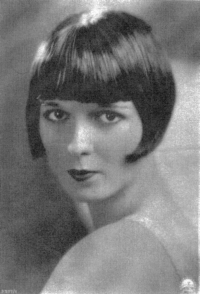 SKC Films Library SKC Films Library |
| SKC Films Library >> Linguistics, Languages, and Literatures >> Dramatic Arts >> Biography: United States |
 Louise Brooks Louise Brookssilent film actress Mary Louise Brooks was born in Cherryvale, Kansas, on November 14, 1906. She made her "professional debut" as Tom Thumb's bride in a benefit church show in Cherryvale, and by the time she was eleven she was dancing on a regular basis at the Cherryvale Opera House. She and her family moved to Wichita, Kansas, in 1919. In 1922, at the "ripe old age" of fifteen, Brooks traveled to New York to study with the Denishawn Modern Dance Company. From October 1922 through the spring of 1924, she performed in hundreds of cities across the country, including her new hometown of Wichita. She next appeared in George White's Scandals Revue and The Ziegfeld Follies. On August 24, 1925, Brooks's first movie, The Streets of Forgotten Men, was released by Famous Players Lasky. By 1926 she was working for Paramount, and over the next three years she was featured in over a dozen films including American Venus (1926), Rolled Stockings (1927), Beggars of Life (1928). Notable film stars she had the pleasure of working with included W.C. Fields, Ford Sterling, Lois Wilson, Evelyn Brent, Wallace Beery, Richard Arlen, Victor McLaglen, William Powell, and Jean Arthur. Brooks became a silent screen icon. Her distinctive Dutch bob hairdo was imitated by women across the country. She was the inspiration for the long-running comic strip "Dixie Dugan," as well as the stage play "Show Girl." In 1927 she was the fourth most written about actress in terms of major magazine articles, after Clara Bow, Joan Crawford and Colleen Moore. In 1928, Brooks left Paramount to do film work in Europe, and it was while working with famed German director G.W. Pabst that she appeared in the role for which she is best known today -- Lulu, in the film Pandora's Box (1929). Under Pabst's direction, Brooks' subtle, erotically charged style of acting emerged. Although the film failed financially in Germany and was only barely reviewed in the United States, Pandora's Box is now considered a landmark of the silent-film era. Brooks went on to make two more films in Europe -- Diary of a Lost Girl (1929), again with Pabst, and Prix de Beauté (1930), an early French sound film. Returning to the United States, Brooks found herself relegated to supporting roles in B-grade films. Her last film was Overland Stage Raiders (1938), a western serial with John Wayne. After years of obscurity and near poverty (including a stint as a $40-a-week salesgirl at Saks Fifth Avenue), Brooks returned to public view as an author. Throughout the 1950's, 60's and 70's, her thoughtful essays on film appeared in such magazines as Sight and Sound, Film Culture, and Focus on Film. In 1982 a collection of her writings was published under the title Lulu in Hollywood. Louise Brooks died of a heart attack in Rochester, New York, on August 8, 1985. She is interred at Holy Sepulchre Cemetery, in Rochester. LINK OF INTEREST |
| SKC Films Library >> Linguistics,
Languages, and Literatures
>> Dramatic
Arts >> Biography: United States This page was last updated on 05/30/2017. |